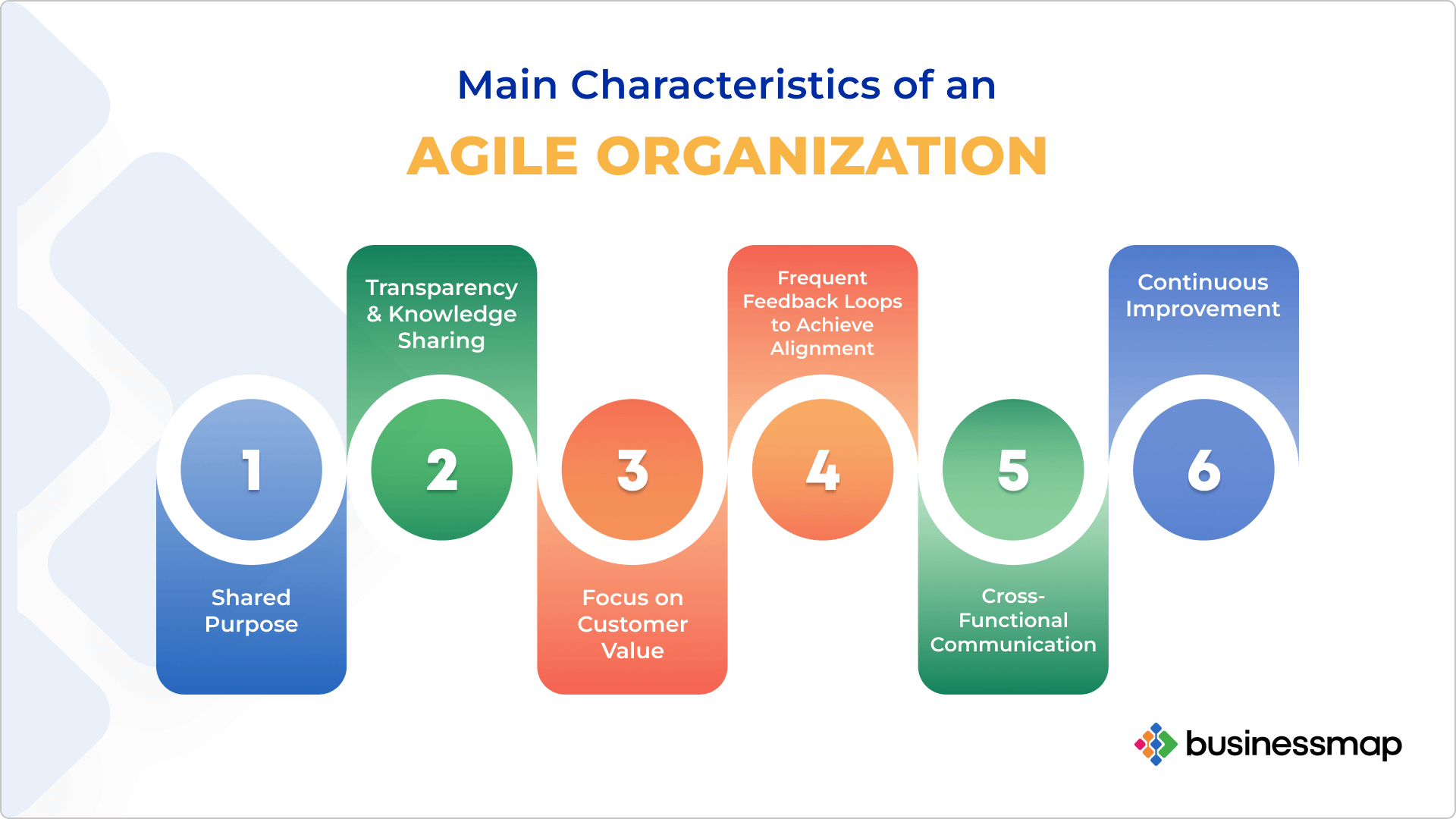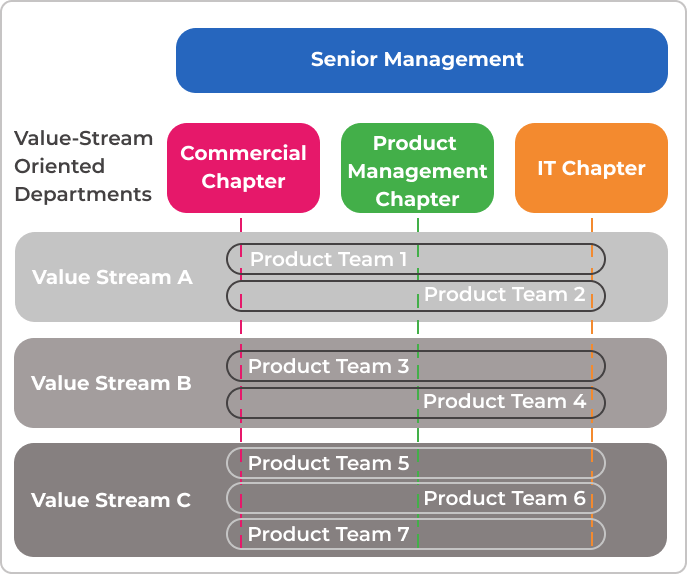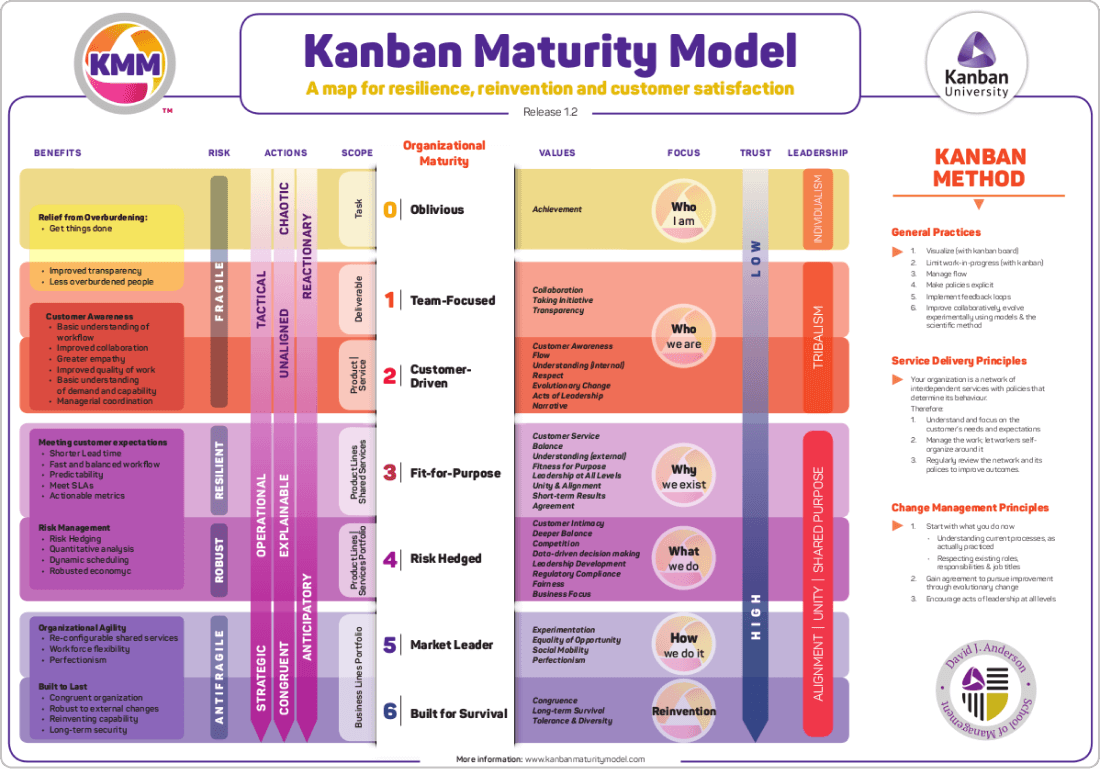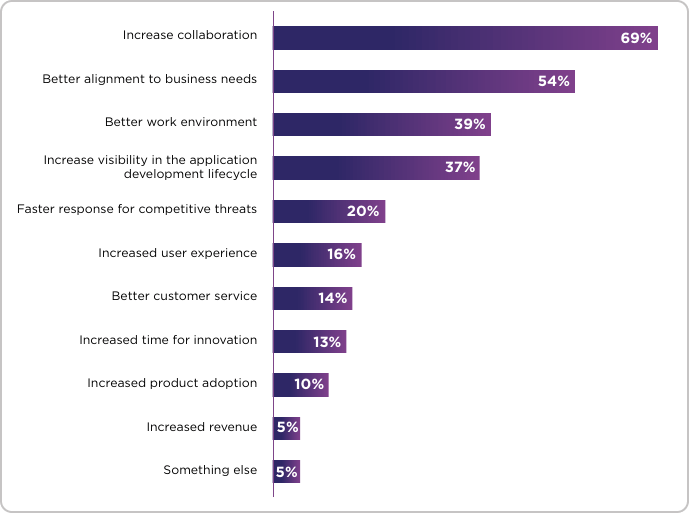In search of inspiration, practical advice or to enrich our common sense, nothing beats learning from the experience of others. It's the most human thing - to relate to other fellow humans, to share both our success stories and mishaps.
It's no different in the business world - we tend to explore the industry experience and exposure of others, learn from their lessons, and aspire to be even better. That's why today, we've decided to share how some industry leaders are scaling agility and building Agile organizations.
What Are Agile Companies?
An Agile company is a people-centric organization that quickly adjusts and responds to new challenges and opportunities in the marketplace or clients' switching behaviors. Its flexible nature ensures quick adaptation and optimal employee performance in a dynamic environment. An Agile organization's ultimate goal is to meet its client's needs by continuously delivering valuable products.
What Are the Main Characteristics of an Agile Organization?
Besides being highly adaptable and acting promptly to changes, other key attributes highly encouraged by Agile companies include sharing a common purpose and vision, cross-team communication, and knowledge exchange.
 Main characteristics of an Agile organization
Main characteristics of an Agile organizationThe organizations we'll discuss have another common key trait - their drive and willingness to change. The goals of change can vary: adapt to the market, drive innovation, or gain a competitive edge. No matter what their goal is, the important part is the continuous desire to improve.
8 Successful Agile Organization Examples
Now let's explore the examples of Agile companies we've prepared for you.
1. How does Boa Vista align team operations with strategic goals on the path to business agility?
The Brazilian provider of financial solutions Boa Vista initiated a digital transformation project back in 2019. The project's goal was to accelerate delivery and foster the ability to swiftly adapt to changing customer requirements.
The company's pain points at the time were related to:
- Long delivery cycles
- Lack of clear visualization
- Identification of improvement opportunities
To support their mission, the company chose to apply the Kanban method. The method helped them break down work into value-stream-oriented departments and product-oriented teams. As a result, the new team structure brought greater visibility across teams and departments, reducing waiting times and blockages caused by moving a project through different departments.

To continue on its path to enterprise agility, Boa Vista turned to the Kanban Maturity Model to scale its Kanban commitment efforts across the company. Introducing a five-layered kanban board where team projects were linked to strategic goals enabled greater transparency and alignment between operations and company objectives. In addition, introducing the practice of working in small batches made teams more flexible regarding external factors.
On their mission to achieve digital transformation goals, Boa Vista also employed kanban metrics. The results showed improvement of teams' workflow performance and justified that the work processes were becoming more stable and predictable.
Learn more about Boa Vista Agile Transformation
2. Simplicity and effectiveness or how Vanguard became a truly Agile company?
The renowned investment management company started its Agile transformation back in 2007, "officially" employing the Scrum framework among various teams in the organization. Internal research on the framework's adoption showed that by 2014, about 40% of the employees who originally implemented the method switched or were planning to switch to Kanban.
The popularity of the Kanban method among Vanguard teams was attributed to:
- The fast learning process
- The fast feedback flow mechanisms
- Comprehensive visualization of the end-to-end flow
The challenges that various teams were experiencing at the time were related to:
- Uneven workflows
- Poor capacity distribution
- Not understanding who the customer is
Making an end-to-end kanban board with mapped work states and the ability to integrate internal teams with external vendors (upstream filtering) helped Vanguard teams streamline their multiple flow boards and levels. Another attempt to manage their workflows better was introducing classes of service and work sizing, which enabled a faster flow of work downstream. Furthermore, applying explicit work policies and WIP limits improved the understanding of the overall capacity distribution and reduced the workflow lead time.
Employing workflow visualization and classifying work types enabled a deeper understanding of customers and vendors, stronger work policies, and reduced costs. The teams at Vanguard managed to establish consistency in their work processes, policies, and decision-making models. A turning point in the Agile transformation journey at Vanguard was consolidating multiple flow boards into one grand kanban board, which enabled the simplicity and effectiveness of a truly Agile company.
Learn more about Vanguard Agile Transformation
3. From team-focused to flow-oriented program management - the BBVA journey to scaled agility.
One of the largest financial companies in the world - BBVA (The Banco Bilbao Vizcaya Argentaria), started its Agile journey in 2014 and continues to this day. The goal of the endeavor was to establish a steady flow of value, enable quick adaptation to the market, do meaningful work prioritization, and promote continuous learning.
A year after the start of the Agile initiative, the largest part of the business - Business as Usual (BAU) services, was suffering due to the prioritization of the Agile transformation programs. As a result, a number of other projects were affected.
BAU, additional projects, and cross-team dependencies had to be managed more effectively. The Kanban method provided the needed capabilities to enable fast feedback about work items' status, support evidence-based decision-making, and identify improvement opportunities.
To evolve its organizational agility, BBVA introduced portfolio kanban to its program management. The model enabled better work synchronization and prioritization among multiple projects, bringing a greater understanding of the work process, including the cross-functional team and cross-project dependencies. Using work-related metrics improved their work planning and delivery commitments.
Some of the challenging areas where Kanban provided effective solutions were related to:
- Lack of proper coordination of services
- Poor work prioritization
- Lack of synchronization across teams
In the span of one year, the two programs selected for agile transformation of BBVA's finance domain managed to establish a synchronized work hub and improve the understanding of the types of delivered services. The programs also gained a deeper quantitative perspective on the demand and capabilities, which enabled effective planning. Another major success was instilling a sense of belonging through the practice of kanban cadences and empowering a flow of thinking.
Learn more about BBVA Agile Transformation
4. Leadership buy-in - the key to achieving organizational agility at Bosch.
With the goal to stay in the present and satisfy the demands of today's market, the automotive giant Bosch saw the critical need to become more innovative and agile. In 2018, the company started its transformation to business agility by employing Scrum teams.
A major milestone in the transformation process was the initial approach to creating a "dual organization". In other words, business as usual (BAU) would run as normal alongside specific teams that would adopt Agile. The failure of the approach pushed management to start from scratch, and this time the goal was to spread agility across the company, starting from leadership.
Some of the practices that turned out to process impediments were related to the following:
- Plain status reporting
- Annual planning and fixed priorities
- Isolating impediments to specific sectors
The leadership role was key to the success of the agility adoption at Bosch. Engaging in conversations facilitated fast feedback and collaboration. Furthermore, leadership guided the organizational change by prioritizing the backlog of the entire enterprise. Transitioning to Agile planning, on the other hand, enabled faster adaptation to emerging changes and made the company more flexible. Organizational issues would no longer be seen as problems dedicated to specific groups but as impediments affecting the company's operations as a whole.
Learn more about Bosch Agile Transformation
5. Higher operational transparency - the major step towards business agility transformation at SSOE.
With a bold mission - to save time, trouble, and money for their clients, the global project delivery player for architecture SSOE Group turned to Lean/Agile practices for construction management. The company was looking to implement the practices and drive performance through enhanced collaboration and optimized workflows.
The key challenges before achieving organizational agility at SSOE at the time were related to:
- Lack of operational transparency
- Poor collaboration
- Lack of alignment between execution and planning
Kanban was identified as the leading method to respond to these challenges. The kanban practice of visualizing the workflow made it possible to streamline work processes quickly. In the span of only three months, team members were better aligned on how work is done, and there was greater collaboration and improved scheduling of work between teams and work stages. Furthermore, the use of kanban software required team coordination in defining the major steps in a delivery process, which naturally supported team collaboration. The daily, weekly, or monthly practice of discussing ongoing work and bottlenecks through the use of kanban cadences allowed better team discussions and knowledge-sharing opportunities.
Critical to the success of the business agility transformation at SSOE was measuring the results of the efforts put in. The Kanban Maturity Model for scaling Kanban across an organization provided reliable data to SSOE managers, allowing them to measure the progress of the transformation and to identify room for improvement. For instance, SSOE introduced work types for various activities and multi-level work structures. These layered structures made it possible for project managers to have greater visibility over the status of projects and project-related work across teams, in real time and in a single place.
 Kanban Maturity Model, Image credit: https://www.kanbanmaturitymodel.com/
Kanban Maturity Model, Image credit: https://www.kanbanmaturitymodel.com/Learn more about SSOE Agile Transformation
6. The Big Bang Agile transformation across 3500 employees at PayPal.
The global leader in the payment domain initiated their transition to business agility back in 2013, employing Scrum teams across their 40 offices worldwide. The organization had multiple product organizations with no defined product hierarchy and no common leadership. As a result, despite the hard work, little value was delivered to PayPal's customers.
The issues with the operating model were related to the following:
- Lack of project-focus
- Poor dependencies management
- Multiple orphaned projects
To respond to these challenges, PayPal imposed a big bang Agile transformation with four major pillars. The first step was to bring the teams closer to the customer and understand their wants and problems. Next, clear product ownership was induced, which enabled the structuring of agility scaling efforts and the organization of the company's product portfolio. The third step was imposing to begin to work on Scrum teams. The final phase was introducing KPIs to measure the entire transformation project.
Critical to the success of the operation was the provision of Agile training for the transformation leaders, including product owners, scrum masters, and Agile coaches. Another factor was the achieved transparency through mapping all ongoing projects inside a unified workspace where everyone was able to see what everyone was working on. This resulted in optimized dependencies management. A cornerstone of the success of the project was introducing planning and execution at a portfolio level.
Learn more about PayPal's Agile Transformation
7. Innovative medicines enabled through an Agile business model at Roche Korea.
In pursuit of a more efficient and sustainable healthcare ecosystem, Roche Korea initiated a new business model to improve patients' lives and ensure easier access to innovative medicines. Starting its Agile transformation in 2020, for only one year, the company has managed to increase its sales by 30% and the number of patients benefiting from its medicines and services.
Roche Korea's Agile transformation strategy's main priority is making the organization's processes and operations more adaptable to changes and patient-centered.
Through this 2-year (still ongoing) Agile transformation, there are a number of positive changes that the company has witnessed. To name some of them:
- Responding to clients' needs and concerns takes less time than it usually does
- Streamlined decision-making
- Individuals and teams are authorized to take leadership and make their own decisions about their business unit
- Identifying new areas for improvement and development
- Forming special teams based on a patient group or a treatment to identify and meet specific needs
- Close collaboration with local Korean hospitals to ensure better health and lifestyle for people
Driven by innovation and constantly looking for new improvement opportunities, Roche Korea is on its way to revolutionizing the healthcare system in Korea.
Learn more about Roche Korea's Agile Transformation
8. Reaching new scientific levels of innovation with business agility at AstraZeneca.
One of the leading, science-led biopharmaceutical and pharma companies embarked on a digital transformation and business agility journey to change the way capacity and resource planning are handled and elevate project transparency while innovating.
The pilot project of the Agile transformation for AstraZeneca began with Innovative Medicines & Early Development (IMED), which is responsible for the early stages of medicine development. The first outcomes of the new Agile way of working brought significant changes to this area of business. To name a couple, creating a centralized project management organization and launching a common vision and mission.
As a company with a global presence, different processes were employed and aligned to address various issues. The most common challenges that business units experienced before going Agile were:
- Poor capacity planning and resource management
- Lack of data and information transparency
- Missing project and portfolio information sharing
To respond to these challenges, a project capacity and review team was created to manage and coordinate cross-functional capacity and oversee any issues across the organization. Knowledge-sharing processes became essential to projects' success by improving the collaboration between teams and external partners and supporting optimal decision-making.
The leadership role and understanding of the project management processes and principles were also key to the transition. The clearly defined approach to managing work allowed teams to align better projects and activities, drove status reporting, and simultaneously satisfied stakeholders' requirements.
Thanks to Agile coaching and tools supporting Agile practices, AstraZeneca has increased its production levels. What's even more important is that the company is continuously improving its processes' efficiency to ensure greater value delivery to its customers.
Learn more about AstraZeneca's Agile Transformation
Key Benefits of Agile Companies
Considering that the percentage of organizations adopting Agile has been on the rise over the past few years, it is clear that the benefits of business agility are numerous. According to a recent "State of Agile Report," among the most common reasons businesses scale Agile across enterprises are increased collaboration, better alignment to business needs, better work environment, and more.

Reasons why businesses scale Agile across the enterprise (Image credit: 16th State of Agile Report)
What Does It Mean to Scale Business Agility Across the Company?
As we saw from the examples of Agile organizations above, truly Agile companies tend to focus their efforts on the same goals. To name a few, these include company culture shifts, high employee engagement and morale, embracing feedback, improving customer experience, increasing delivery rate, improving quality, etc.
But these are not to be mistaken for the "final goal" of Agile companies - the key is to keep doing what helped you unleash true business agility, keep learning and improving until it turns naturally into your organizational culture.
Try Businessmap Free for 14 days
Iva Krasteva
Content Strategist | Agile Practitioner | Kanban Certified
Iva is a Kanban-certified Agile expert with hands-on experience in SEO, content creation, and Lean practices. She has published dozens of articles on Lean, Agile, and Kanban practical applications. Iva actively promotes collaborative, flexible work environments and regularly shares process optimization insights through writing.



